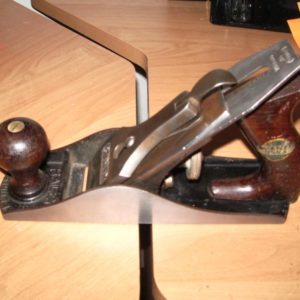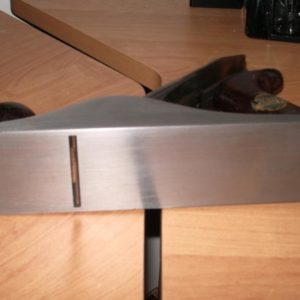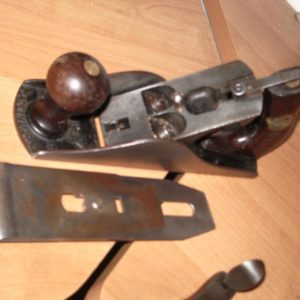I was wondering if I could find some help. I bought a bunch of old stanley planes. The person I bough them from would only sell ALL of them. So I had to buy all of them for the few that I wanted.
Here is the question. The only Stanley planes that I find for sale are ones that are in pretty bad shape. What is a restored Stanley Sweetheart plane worth? I have spent at least 3 hours on each of them lapping the sole, sharpening the blade, and cleaning a few of them up. I am enjoying bringing the planes back to life, and I want to sell the ones that I don’t want, but a can’t find any info on what they would be worth. Is there any guide to the value of restored Stanleys?
I am including a few pics of my handy work, is there anyone that can provide me with a resource for pricing restored planes?
I believe this is a #4 type 15 Sweetheart.
Edited 2/26/2009 12:22 pm ET by mschror


















Replies
I'd say eBay is a decent way to gauge it. Search for completed auctions of the similar planes (you will find scores). An average 3, 4, and 5 will likely be in the $20 to $50 range depending upon the quality and condition. A 7 or 8 will be more - maybe $75 -$100. Block planes vary widely as there were so many styles.
By the way, your pics are too large to view. 2MB is WAY to big. Think KB.
Here are the resized pics.
And I know that Ebay has planes for sale. However, those planes are in pretty rough shape. I remember seeing a website that was selling Stanley planes in what looked like pretty good shape, however, I can't seem to find that website again. And even if I did find the website, is there a market for restored Stanleys?
The planes on eBay run the gammut from brand new/never used to restored to rusty and crusty. There are many in conditions similar to yours. You can, of course, look at prices folks like Bob Kaune asks: http://www.antique-used-tools.com/ but I don't think that's particularly realistic for a one-off seller as opposed to a dedicated dealer. Dealers may well be able to ask about double eBay prices because they can place their reputation behind their represetnations about the plane etc.
http://cgi.ebay.com/STANLEY-NO-4C-SW-ERA-PLANE-EXCELLENT_W0QQitemZ180330166576QQcmdZViewItemQQptZLH_DefaultDomain_0?hash=item180330166576&_trksid=p3286.c0.m14&_trkparms=66%3A2%7C65%3A13%7C39%3A1%7C240%3A1318
That one looks pretty close to yours.
don't know how much you can get for the bench plane you have in the picture but its a nice plane to work. I have one just like it (think its a 3) and I love that thing. If you like the feel of it, maybe a blade upgrade after the sole is flattened and you have a workhorse in your tool box.
You might want to put a few on the classified section of knots and see if there are interested buyers. See what happens.
Perhaps you have never watched Antiques Road Show on television. In most cases, you lower the value by cleaning or restoring an item. #4 Stanley's are one of the most common planes. Workers can be found for under $50. You probably haven't done any significant damage since they are so common but your efforts won't be rewarded. You may have limited your potential buyers. There is a lovingly restored #4 on Ebay right now that will likely sell for less than $50. If you happen to have a #1 make sure you don't mess with it.
Beat it to fit / Paint it to match
I wouldn't attempt to recondition a collectible. However, there are a lot of old Stanleys around. I think they are great planes if they are tuned properly. And an old plane is certainly better than some of the cheaper new planes.
I have several old planes that I tuned and I use, as well as a few LN's and LV's that I have. However, I enjoy the satisfaction of bringing an old plane to life. For example, you can buy a new Stanly Block plane for $45, and still have to tune it up. Or you can buy an old Block plane for $10 and tune it up. I think the quality of the old planes is worth a little extra time that it takes to bring it back.
For example, a Lee Valley #4 costs about $215, a Lie Nielsen is $350. You can find an old Stanley for $40. Besides the obvious differences in looks, a properly tuned Stanley is a great plane. Given the sheer numbers of old planes out there, and the quality of a properly tuned plane, isn't it worth taking the time to fettle with them? Not to mention the history that is behind the Stanleys?
Is there anyone else that shares my sentiment?
I definitely sahre your sentiments. Here is my SW 5 brought back from the rusted and neglected brink:
View Image
I think you have it taped - one needs to distinguish between a true collectable/valued plane and basically good workers that can be put into good working order without spending ages and money. I thnik most people know that a #1 that is not a repro and can be worth in the thousands and shouldn't be materially altered by aggressive cleaning etc.
I have always like to keep the danged things looking respectable with minimal effort, but recently I have found that fixing them up in between other things can pay the rent.
Conditions may be different in the States, but here I have no problem selling a #41/2 for around NZ$70 or a #6 for $120 . An Acorn #4 was bid up to $87. But that doesn't mean it will continue.Philip Marcou
Philip:That's a bit high by US standards for planes that are not in mint condition and of desirable types. However, sometimes the types others want will surprise you. Last summer I sold a new-in-box Stanley 5 type 18 (immediate post WW2) for +- $100 US. They buyer collected type 18. If I had bought or sold that same plane in used condition, even nicely cared for, it would likely have gone for less than $25 US. Joe
Joe,
I think conditions from place to place are bound to vary, but have you taken into account the value of the NZ$ versus the Greenback, and the fact that I usually surface grind all over and make handles which are thicker so more comfortable ? Also, if there are any suspicions with the threads for the handle rod and knob I just tap the holes out to 1/4 x20 and make new 1/4" rods, which puts an end to any loose handle problems.
So I am just doing them so they can be used, and I have the means to do the work quickly. Obviously , should I come across something exotic, I will either keep it or restore it without jeopardising its value.Philip Marcou
P.S. I think another useful yardstick is the monthly sales list which comes from Patrick the Leach- seems to me that he has an inclinometer which he applies at the beginning of each month, after adding a degree or two (his prices are rising in other words).
Edited 3/3/2009 12:11 am by philip
Oh, of course if you are adding better handles and working them over for use, they'd be priced differently than just old planes. I had missed that.J
Hi Phillip
I sent you an email today re surface planning some Stanley planes today did you get it? Not sure if that email address is still current.
Rgds
John
Phillip,
Those planes look great. Did you re-japp some of them? I would like to try japping eventually. I have seen several reciepes for doing so, I think it would be interesting.
Thanks for the information and pictures, I enjoyed restoring a few of them, and hopefully someone will want the ones that I don't have a need for. But in the end, I enjoyed bringing them back to usefullness.
No, they are not collector planes or valuable so I don't worry about japanning.
I use either automotive lacquer or a fast dry enamel and just spray it on thick.....fast as possible.Philip Marcou
Lots of folks enjoy putting old tools back to work. That's why they don't want you messing with them. You take all the fun out of it.Beat it to fit / Paint it to match
I'm working this plane over for a buddy of mine. It was in a box full of "stuff" that he got at an auction. After a bit of research, I told him that it looks like a Stanley "Excelsior" - a collectible worth maybe $40 - $50.
My "restoration" will include complete cleaning, tuneup, and repainting. He rarely uses a plane so this one will wind up on a display shelf in his living room.
The after picture looks like the plane has been bead blasted. Is this the case? Did you use sand or glass?
Regards,
Mack"Close enough for government work=measured with a micrometer, marked with chalk and cut with an axe"
Good eye, Mack. I used a friends blasting hood with Silica-Carbide media.
Though it doesn't feature restored planes per se', there is a general price guide to most of Stanley's planes at Handplane Central in the Stat Sheets section. The average values are based on fair to good quality planes.
Handplane Central
Record Planes
Milbemycin oxime manufacturer
Milbemycin oxime is on the go against a lewd spectrum of nematodes, although it is less potent against heartworms than ivermectin. Its miticide spectrum includes Sarcoptes and Demodex. The USA FDA mandate in the interest milbemycin oxime as formulated unaccompanied does not hint insecticidal activity.[1]
The substance is again combined with other parasiticides to fulfil a broader spectrum of action. Such products subsume:
Milbemax (with praziquantel)
Lookout Flavor Tabs (with lufenuron)
Trifexis (with spinosad)
Recently the knock out has been habituated to in marine reef aquaria to control parasitic harptacoid copepod (Tegastidae) infestations on caged devastating coral colonies. It is an competent detailed tank treatment for these parasites because it is not toxic to corals in the dosage required to despatch the parasites. Shrimps, crabs and other crustaceans should be removed former to treatment, as they purpose be killed through the treatment.
From [url=http://www.tcsindustry.com]TCS INDUSTRY LTD[/url]
Milbemycin oxime manufacturer
Milbemycin oxime is on the go against a lewd spectrum of nematodes, although it is less potent against heartworms than ivermectin. Its miticide spectrum includes Sarcoptes and Demodex. The USA FDA mandate in the interest milbemycin oxime as formulated unaccompanied does not hint insecticidal activity.[1]
The substance is again combined with other parasiticides to fulfil a broader spectrum of action. Such products subsume:
Milbemax (with praziquantel)
Lookout Flavor Tabs (with lufenuron)
Trifexis (with spinosad)
Recently the knock out has been habituated to in marine reef aquaria to control parasitic harptacoid copepod (Tegastidae) infestations on caged devastating coral colonies. It is an competent detailed tank treatment for these parasites because it is not toxic to corals in the dosage required to despatch the parasites. Shrimps, crabs and other crustaceans should be removed former to treatment, as they purpose be killed through the treatment.
From [url=http://www.tcsindustry.com]TCS INDUSTRY LTD[/url]
This forum post is now archived. Commenting has been disabled